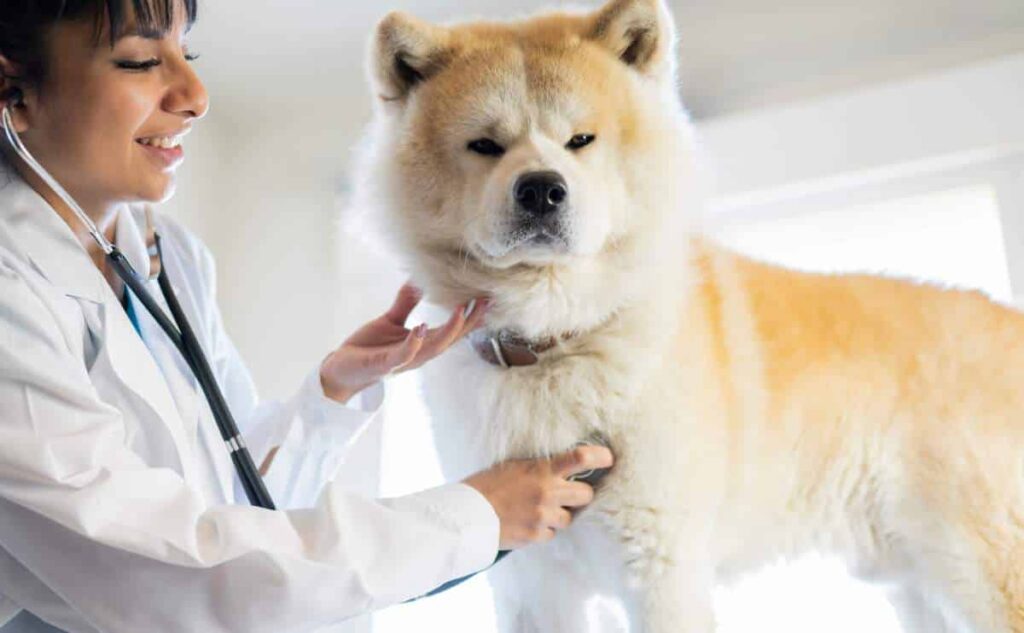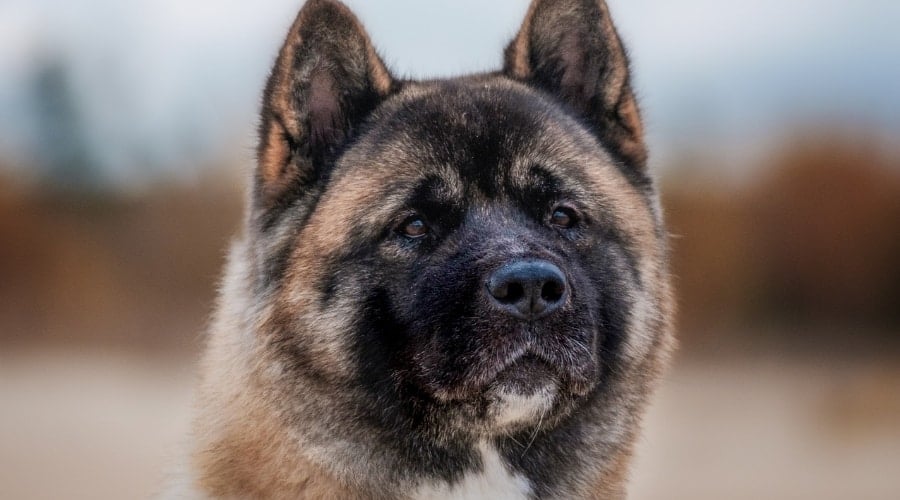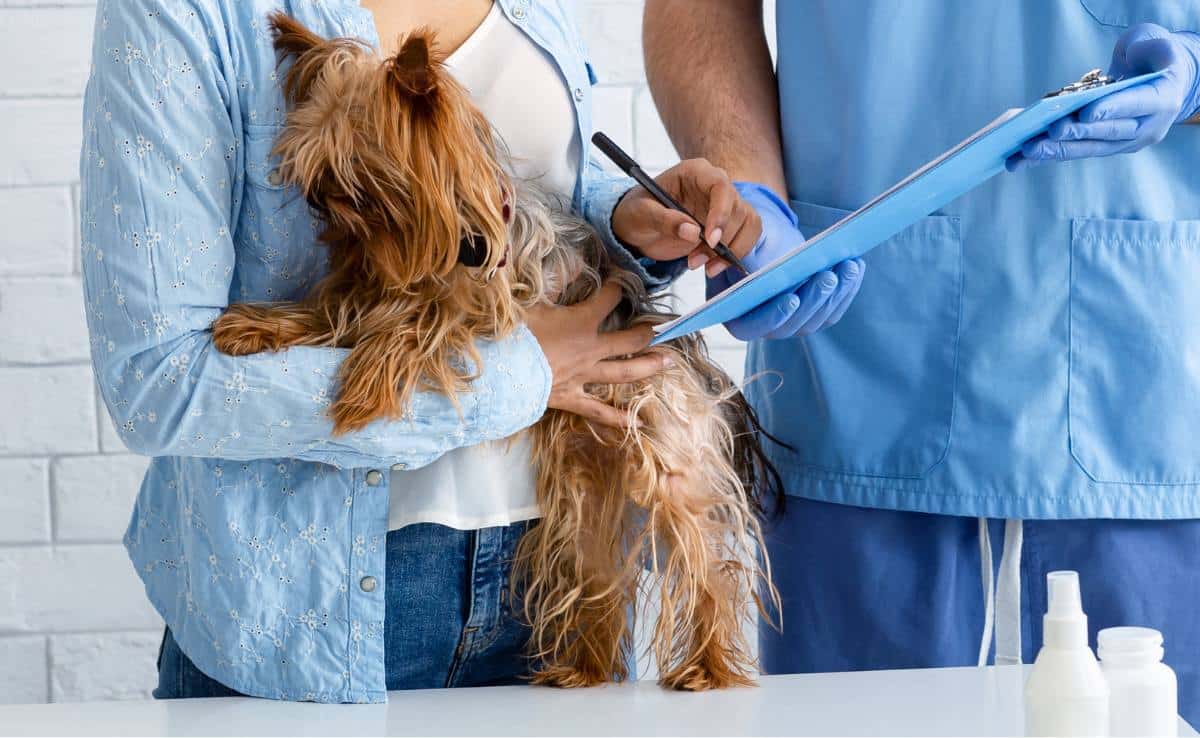Best Pet Insurance For Akita Dogs
When you purchase through links on our site, we may earn a commission. Here’s how it works.
Akitas are large, loyal, headstrong dogs originally bred as hunters and protectors. Akitas are one of the most striking dog breeds and are deeply loving with their family but can be extremely wary of strangers and other dogs. Without expert training, they can develop aggressive behavioral problems.
Table of Contents

This breed is also predisposed to several expensive illnesses and accidents, including gastric torsion (bloat), a host of orthopedic problems, chronic allergies, skin and kidney diseases, eye disorders, cancer, and more. Managing your dog’s health concerns can be quite costly and emotionally draining. Fortunately, pet insurance can ease these burdens by covering a significant portion of your beloved pet’s veterinary expenses.
Based on my decade of experience in pet insurance and breed-specific health matters, I will guide you through the prevalent health issues that Akitas encounter and the related treatment costs. Additionally, I will assist you in determining whether pet insurance is a suitable choice for your dog and provide my top recommendations for plans that align with your needs.
Best Pet Insurance For Akitas
Akitas, like all purebred dogs, have unique insurance requirements. Through thorough research, I have pinpointed the best pet insurance options for Akitas. I considered various factors such as coverage scope, breed-related health issues, customization options, the dog’s age, premium costs, and others.
| Best For | Company | Get Quotes | Read In-Depth Reviews |
|---|---|---|---|
| Customizable Plans |  | Read Review | |
| Extensive Coverage |  | Read Review | |
| Unlimited Payouts | Read Review | ||
| Most Affordable |  | Read Review | |
| Older Akitas |  | Read Review | |
| Akita Puppies |  | Read Review | |
| Vet Direct Pay |  | Read Review |
Best For Customizable Plans: Pets Best

- Policy Options: Accident-Only, Accident & Illness, Wellness
- Annual Deductible Options: $50, $100, $200, $250, $500, $1,000
- Annual Payout Options: $5,000, $10,000, Unlimited
- Reimbursement Options: 70%, 80%, 90%
Why I Picked Pets Best
Pets Best offers a variety of affordably priced insurance policies, including options for accident-only coverage and three different plans that cover both accidents and illnesses. Each plan has unique benefits tailored to meet your Akita’s health requirements. You can select from various deductibles, reimbursement levels, and annual payout limits to customize your plan according to your financial needs. Additionally, Pets Best features a wellness plan add-on available at an affordable monthly cost. With a user-friendly interface and a wide array of choices, crafting the perfect plan is a breeze.
Expert Price Analysis
When I compared quotes for Akitas of different ages and locations, Pets Best frequently offered premiums that were quite competitive with other insurance providers. This was often the case for both lower and higher levels of coverage. Its maximum coverage (unlimited payout, 90% reimbursement, $100 deductible, 90% reimbursement), including vet exam fees and complementary care, is a superb value.
| Pros | Cons |
|---|---|
| Competitive pricing for all levels of coverage | Lengthy claim processing time, averaging 18 to 30 days |
| Offers an accident-only plan (not many do) | Coverage for complementary care* and veterinary exam costs requires plan upgrades |
| Includes coverage for curable pre-existing conditions once they’ve healed | Accident and illness plans have 6-month waiting period for CCL coverage (excluded in accident-only plan) |
| Multi-pet discount of 5% | |
| 2 optional wellness plans | |
| 14-day waiting periods for patellar luxation and hip dysplasia are much shorter than most insurers | |
| Older dogs can be enrolled at any age |
In-Depth Review Of Pets Best
I urge you to read my extensive review of Pets Best to learn more about this insurer’s various plan and customization options, waiting periods, and other crucial details.
Most Extensive Coverage: Fetch

- Policy Options: Accident & Illness, Wellness
- Annual Deductible Options: $250, $300, $400, $500, $600, $700
- Annual Payout Options: $5,000, $10,000, $15,000
- Reimbursement Options: 60%, 70%, 80%, 90%
Why I Picked Fetch
Fetch provides extensive policies that cater to your Akita’s needs with no additional costs. Each policy covers vet exam costs, complementary care, dental disease, behavioral therapies, and even C-sections. These benefits are often accompanied by high upgrade fees from other insurers or may not be available at all. Furthermore, Fetch provides unique perks that help you save money, such as $1,000 per year for virtual vet visits, with no deductible required.
In addition, Fetch ensures that your pet is covered before treatment begins. They can provide you with pre-approval for procedures and cost estimates, giving you peace of mind. Overall, Fetch offers a comprehensive and cost-effective solution for all your pet insurance needs.
Expert Price Analysis
Based on my quote comparison, Fetch’s pricing for puppies and younger Akitas was occasionally below average but generally landed in the mid-range of premium prices. In contrast, the prices for older Akitas were usually on the higher side.
| Pros | Cons |
|---|---|
| Provides some of the most extensive coverage | Accident waiting period of 15 days is longer than average |
| Covers curable pre-existing conditions after 1 year without treatment or symptoms | Lengthy waiting periods of 6 months for CCL ruptures, hip dysplasia, and patellar luxation |
| Numerous unique perks (virtual vet consultations, trip cancellation, lost pet assistance, etc.) | No multi-pet discount |
| Optional wellness plan | |
| Ability to get prior approval for procedures and treatment costs | |
| Older dogs can be enrolled at any age |
In-Depth Review Of Fetch
Check out my detailed review of Fetch for a thorough understanding of this provider’s extensive policies, unique benefits, customization options, and more.
Best For Unlimited Payouts: Healthy Paws

- Policy Options: Accident & Illness
- Annual Deductible Options: $100, $250, $500, $750, $1,000
- Annual Payout Options: Unlimited
- Reimbursement Options: 50%, 60%, 70%, 80%, 90%
Why I Picked Healthy Paws
If your dog requires a lot of veterinary care throughout the year, you won’t have to worry about reaching a coverage cap with Healthy Paws because all policies include unlimited annual payouts. Given that Akitas are known to have several expensive health issues, this is especially advantageous for their owners. Healthy Paws is frequently the more affordable choice compared to other insurance providers offering comparable deductibles, reimbursements, and limitless payouts. Pet parents who wish to have the assurance of unlimited coverage should consider Healthy Paws.
Expert Price Analysis
Comparing their premiums to those of other insurance providers can be tricky since Healthy Paws only offers unlimited payouts. However, I found that the cost to insure an Akita with Healthy Paws tends to be about the same or just a bit more than plans from other companies that provide a $5,000 payout. These other plans have comparable deductibles and reimbursement options.
| Pros | Cons |
|---|---|
| Every policy includes unlimited annual payouts | Limited customization options for older dogs |
| Some of the most affordable rates for comparable coverage and unlimited payout plans | Inability to obtain coverage for behavioral therapies and veterinary examination expenses |
| 2-day claim processing is shorter than average | Some Akitas are uninsurable due to age and location |
| 15-day waiting periods for patellar luxation and hip dysplasia are much shorter than most insurers | Lengthy 12-month waiting period for hip dysplasia coverage |
| Complementary therapy is covered | Dogs enrolled at 6 years of age and older are ineligible for hip dysplasia coverage |
| Consistently highly ranked for client satisfaction |
In-Depth Review Of Healthy Paws
Take a look at my in-depth review of Healthy Paws for a thorough breakdown of its coverage, customization choices, fast reimbursement process, waiting periods, and additional features.
Most Affordable: Figo

- Policy Options: Accident & Illness, Wellness
- Annual Deductible Options: $100, $250, $500, $750
- Annual Payout Options: $5,000, $10,000, Unlimited
- Reimbursement Options: 70%, 80%, 90%, 100%
Why I Picked Figo
Figo is a top-tier pet insurance company with extensive benefits, but its policies can be pricey for many breeds. The good news for Akita owners? Premium pricing is highly competitive, making Figo a top option for Akita parents. All Figo policies cover dental illness, behavioral therapy, and complementary treatments. Its only add-on for insurance coverage is for vet exam fees. Additionally, every year you don’t submit a claim, your deductible decreases by $50. Figo also stands out for its prompt claim processing and first-rate customer support.
Expert Price Analysis
Upon reviewing the multiple quotes I ran for Akitas, I found that Figo frequently provided some of the most affordable premium rates. Compared to comparable coverage offered by other providers, its base policy ($750 deductible, 70% reimbursement, and $5,000 payout) was consistently among the most economical.
| Pros | Cons |
|---|---|
| Policies with lower coverage are exceptionally affordable for Akitas | Extra fee necessary for veterinary exam cost coverage |
| Rare offerings include a 1-day accident waiting period and a 100% reimbursement option | Lengthy waiting periods of 6 months for CCL ruptures, hip dysplasia, and patellar luxation |
| All policies cover dental disease, complementary treatments, and behavioral therapy | |
| Covers curable pre-existing conditions after 1 year without treatment or symptoms | |
| Optional wellness plan | |
| Diminishing deductible of $50 each year you’re claim-free | |
| 3-day claim processing is shorter than average | |
| Multi-pet discount of 5% | |
| Older dogs can be enrolled at any age |
In-Depth Review Of Figo
I encourage you to read my extensive review of Figo to discover more about this insurer, including coverage specifics, waiting periods, reimbursement, customizations, and my own experience.
Best For Senior Akitas: Embrace

- Policy Options: Accident-Only, Accident & Illness, Wellness
- Annual Deductible Options: $100, $250, $500, $750, $1,000
- Annual Payout Options: $2,000, $5,000, $8,000, $10,000, $15,000, Unlimited
- Reimbursement Options: 70%, 80%, 90%
Why I Picked Embrace
As Akitas age, enrolling them in insurance can become quite pricey because of the likelihood of expensive health issues and their large size. However, Embrace differentiates itself by providing among the most affordable premiums for senior Akitas (around seven to eight years old). This provider offers extensive coverage for accidents and illnesses, including $1,000 yearly for dental disease, complementary and behavioral therapies, and curable pre-existing conditions. You can also opt for coverage for vet exam fees and prescription medications for broader benefits. Investing in one of their wellness plans can also help your aging dog maintain optimal health during their golden years.
Expert Price Analysis
From the quotes I ran for Akitas older than seven in various locations, I discovered that Embrace frequently provided some of the most affordable premium rates for comparable coverage when stacked against other insurance companies. This held true even when including coverage for vet exam fees and prescription medications. Additionally, Embrace’s lower coverage was often competitively priced for Akita puppies.
| Pros | Cons |
|---|---|
| Among the most reasonable premium rates for senior Akitas | Extra monthly fees necessary for veterinary exam costs and prescription medication coverage |
| Multi-pet discount of 10% (best in the industry) | Some Akitas are not insurable due to location and age (e.g., dogs over 5 are ineligible for coverage in California) |
| Diminishing deductible of $50 each year you’re claim-free | Lengthy waiting periods of 6 months for CCL ruptures, hip dysplasia, and patellar luxation |
| All policies cover dental disease, complementary treatments, and behavioral therapy | |
| Covers curable pre-existing conditions after 1 year without treatment or symptoms | |
| Brief 2-day accident waiting period | |
| 3 optional wellness plans |
In-Depth Review Of Embrace
Check out my detailed review of Embrace to better understand this insurer’s comprehensive coverage, optional add-ons, numerous customization choices, and other features.
Best For Akita Puppies: Lemonade

- Policy Options: Accident & Illness, Wellness
- Annual Deductible Options: $100, $250, $500, $750
- Annual Payout Options: $5,000, $10,000, $20,000, $50,000, $100,000
- Reimbursement Options: 60%, 70%, 80%, 90%
Lemonade Pet Insurance Is NOT Available In: AK, DE, HI, ID, KS, KY, ME, SD, VT, WV, WY
Why I Picked Lemonade
Lemonade is well-recognized for its affordable rates for basic coverage, which also applies to Akita puppies. Alongside competitive pricing for little Akitas, this insurer provides a two-day waiting period for accidents, ensuring peace of mind if your puppy sustains an injury while exploring their new environment. Another advantage for young Akitas is one of Lemonade’s optional wellness plans that’s tailored specifically for puppies. This plan includes coverage for services such as spaying/neutering, two wellness check-ups, six vaccinations, two fecal tests for parasites, and more.
It’s important to mention that Lemonade entered the pet insurance market in 2020, so it doesn’t have the extensive history of some other companies I recommend in this article. Nevertheless, it has rapidly established a strong reputation.
Expert Price Analysis
Lemonade consistently provides some of the most budget-friendly premiums for Akita puppies and often for adult dogs as well based on the quotes I ran. Their rates remain competitive, even when factoring in coverage for veterinary exam fees. However, their maximum coverage with all add-ons included was often above average.
| Pros | Cons |
|---|---|
| Among the most budget-friendly premium rates for Akita puppies | Only available in 38 states and Washington, D.C. |
| Multi-pet discount of 5% | Extra monthly fees necessary for veterinary exam costs, complementary treatments, dental disease, and behavioral therapy |
| 2-day claim processing is shorter than average | Lengthy waiting period of 6 months for CCL coverage |
| Covers curable pre-existing conditions after 1 year without treatment or symptoms | |
| Optional wellness plan | |
| 30-day waiting periods for patellar luxation and hip dysplasia are shorter than most insurers |
In-Depth Review Of Lemonade
Read my thorough review of Lemonade to learn more about this provider’s coverage, numerous add-ons, quick reimbursement, and other features.
Best For Vet Direct Pay: Trupanion

- Policy Options: Accident & Illness
- Lifetime Per-Condition Deductible Options: $0 – $1,000 (in $5 increments)
- Annual Payout Options: Unlimited
- Reimbursement Options: 50%, 60%, 70%, 80%, 90%, 100%
Why I Picked Trupanion
A significant hurdle with pet insurance is that pet owners must cover the entire vet bill out of pocket and then wait for the insurance company to reimburse them. This can put a financial burden on some owners. However, Trupanion has a unique solution called VetDirect Pay, which can be integrated into your vet’s payment system for instant bill payment. If your veterinarian still needs to adopt VetDirect Pay, you can ask them to set it up.
Trupanion is the sole provider that enables immediate payment to your veterinarian right at checkout. Just remember, you’ll still be responsible for your deductible and copay. Considering Akitas’ predisposition to costly health concerns, such as canine bloat, hip dysplasia, CCL injuries, eye disorders, chronic allergies, and skin diseases, VetDirect Pay can help alleviate your worries about handling veterinary expenses during diagnosis and treatment.
Expert Price Analysis
After comparing quotes from various insurers offering unlimited payouts, Trupanion’s premiums for Akita insurance were considerably higher than those from other companies, sometimes by several hundred dollars.
| Pros | Cons |
|---|---|
| Every policy includes unlimited annual payouts | Highest priced premiums for Akitas by far |
| You don’t need to wait for reimbursement because Trupanion can pay your veterinarian directly | Inability to obtain coverage for veterinary examination expenses |
| Coverage for hip dysplasia and patellar luxation only have 30-day waiting periods | Waiting period for illnesses of 30 days is twice as long as most |
| Covers curable pre-existing conditions after 1 year without treatment or symptoms | |
| 2-day claim processing is shorter than average | |
| 30-day waiting period for CCL ruptures is much shorter than most providers (most have 6 months) |
In-Depth Review Of Trupanion
Please refer to my comprehensive review of Trupanion for more detailed information about this insurer’s unique VetDirect Pay feature, insurance coverage and benefits, waiting periods, and other specifics.
What Type Of Pet Insurance Plan Is Best For Akitas?
When it comes to pet insurance, your primary options are accident-only plans and accident and illness policies. Also, a wellness plan may be available as an optional add-on during enrollment with certain providers. While wellness plans can help you manage your dog’s routine care expenses, it’s crucial to recognize that they do not provide the same level of coverage as pet insurance.
| Accident-Only | Accident & Illness | Wellness | |
|---|---|---|---|
| Injuries (gastric torsion, bowel obstruction, toxicity, sprains, fractures, lacerations, etc.) | |||
| Diseases (allergies, arthritis, eye disorders, patellar luxation, renal dysplasia, hypothyroidism, cancer, etc.) | |||
| Preventative (routine annual exams and lab work, vaccinations, dental cleaning, parasite prevention, etc.) |
What Are Accident-Only Pet Insurance Plans?
Accident-only plans present an affordable solution for dog owners looking to secure emergency care for their pets in case of injuries like wounds, broken bones, gastric torsion, intestinal blockages from foreign objects, and accidental poisoning. These plans also suit pets with pre-existing conditions typically excluded from comprehensive accident and illness policies. It’s important to note that only a limited number of insurance companies provide accident-only policies.
Pricing Tip – Plans that only cover accidents usually have much lower premiums than those that cover illnesses and accidents.
What Are Accident & Illness Pet Insurance Plans?
Accident and illness plans provide your dog with the most extensive health insurance coverage. In addition to injuries, these policies encompass various illnesses and genetic conditions that can impact Akitas, such as hip dysplasia, CCL ruptures, autoimmune disorders, skin diseases, hereditary eye issues, cancer, epilepsy, and chronic allergies. With this insurance, you can be ready for almost any health challenge your pet may face.
What Are Wellness Plans?
Wellness plans are a fantastic way to help you handle the costs of annual vet exams, vaccinations, dental cleaning, parasite prevention, and other preventative services for your furry friend. Adding a wellness plan to your pet insurance is a wise choice that can keep your cherished pet healthy and catch any possible health concerns before they become serious.
It’s important to keep in mind that wellness plans are different from pet insurance and do not pay for medical expenses related to diseases or accidents.
What Does Pet Insurance Cover & Exclude?
When a veterinarian concludes that treatment is essential for medical reasons, the majority of insurance companies will cover the following items in their accident and illness insurance plans. However, coverage can vary between providers. Since different insurers may impose particular limitations on certain conditions, it is essential to thoroughly examine your policy.
| Covered | Excluded |
|---|---|
| Blood tests | Boarding |
| Cancer (chemo & radiation) | Cremation & burial costs |
| CT scans | Elective procedures (e.g., declawing, ear cropping, spaying/neutering, tail docking, etc.) |
| Chronic conditions | Food & supplements |
| Congenital conditions | Grooming |
| Emergency care | Pre-existing conditions* |
| Euthanasia | Pregnancy & breeding |
| Hereditary conditions | Vaccines |
| MRIs | |
| Non-routine dental treatment | |
| Prescription medications | |
| Rehabilitation | |
| Specialized exams & care | |
| Surgery & hospitalization | |
| Ultrasounds | |
| X-rays |
Learn More About Pet Insurance Coverage
Read my article on pet insurance coverage to find out more about some limitations to consider when choosing a plan.
What Determines The Cost Of Pet Insurance For Akitas?

Pet insurers take several factors into account when setting their premium rates.
- The age of your Akita impacts the cost of pet insurance. Why? Older dogs typically have higher premiums because they are more likely to develop expensive health problems than their younger counterparts.
- The cost of living in your area also plays a significant role in premium rates. Variations in local living expenses affect both pet owners and veterinarians. Therefore, if you live in a region with high living costs, you should anticipate higher expenses for veterinary care and pet insurance.
- Another important consideration is a dog’s breed. Certain breeds are more prone to particular health issues, and purebred dogs often face greater health risks than mixed breeds, which can result in increased insurance premiums.
- Male dogs might have higher insurance costs than females. This is often attributed to their larger size, which can require more medication, advanced medical equipment, and additional supplies. However, it’s important to note that some insurers do not consider gender when setting their prices.
You may not have control over every factor that influences premium prices, but you can certainly create a pet insurance policy that fits your dog’s specific needs and your budget. Many insurance providers provide various customization options for you to select from. Let me explain how your options work in more detail.
Customization Options Affect Cost & Benefits
When searching for a pet insurance plan that suits your needs, you may be surprised by the many choices available. First, you can choose a comprehensive policy that covers both accidents and illnesses, or you can select a plan that only covers accidents. Additionally, you have the flexibility to customize your reimbursement rate, deductible, and maximum payout to fit your budget. However, it’s important to understand how these adjustments will impact your coverage.
What Is A Maximum Payout?
Pet insurance providers offer two main types of maximum payouts: annual and lifetime. A provider’s maximum annual payout indicates how much they will reimburse for your dog’s veterinary bills in one policy year. Conversely, the maximum amount an insurer will provide for the duration of your pet’s insured life is known as a lifetime payout. All the companies I recommend in this article have annual payouts, with the most common options of $5,000, $10,000, and unlimited.
Pricing Tip – If you choose a lower payout, your monthly premium will decrease, but if your Akita’s vet expenses surpass your annual cap, you will have to pay more out of pocket.
What Is A Deductible?
The amount you need to pay out of your pocket before your insurance provider reimburses you is your deductible. Common deductibles include $100, $250, and $500 but can vary from $0 to $1,000. There are two main types of pet insurance deductibles: annual and lifetime per condition. Here’s a breakdown of their differences.
- Annual deductible: If your dog requires medical care, you must pay this amount each year before your insurance starts to reimburse you. This is the total you must pay, no matter how many medical issues or treatments your dog may have. A fixed annual deductible allows you to effectively manage your pet’s healthcare costs. Most pet insurance providers offer yearly deductibles.
- Lifetime per-condition deductible: You will have to pay a separate deductible for each new health condition that your pet needs treatment for. If your dog faces multiple health issues within a year, this can add up quickly. The benefit, however, is that you only pay this deductible once for each condition over your pet’s lifetime, which is particularly advantageous if your dog develops a chronic condition such as allergies, arthritis, a skin disease, or an autoimmune disorder. Trupanion is the only provider that has per-condition deductibles.
Pricing Tip– If you select a higher deductible, you will initially more out of pocket for your dog’s medical care, but your monthly premium decrease.
What’s The Reimbursement Percentage?
The reimbursement percentage you choose reflects the share of your veterinary costs that your insurance will reimburse you for once you satisfy your deductible. For example, if you select an 80% reimbursement rate with a $250 deductible, you will pay the initial $250 out of pocket and will only be responsible for 20% of the remaining veterinary expenses (called your copay). The provider will reimburse you for the remaining 80%. Typical reimbursement percentages include 70%, 80%, and 90%.
Pricing Tip – If you choose a higher reimbursement percentage, your monthly premium will increase, but you will pay less out of pocket when your dog needs medical attention.
Learn More About Pet Insurance Costs
To gain a thorough understanding of how customization options affect your coverage and premium rates, take a look at my in-depth article on pet insurance costs.
How Much Is Pet Insurance For An Akita?
Fill out the form below with your zip code and your dog’s details to receive an accurate pet insurance quote for your Akita. We will then furnish you with customized insurance quotes for your pet from multiple top insurance providers. While it can be useful to compare sample Akita insurance quotes, keep in mind that the cost of your dog’s coverage may vary depending on their particular information.
According to NAPHIA (North American Pet Health Insurance Association), the average monthly premium for an accident and illness dog insurance policy in the U.S. is $62.44 ($32.10 for cats).
I gathered pet insurance quotes for Akitas from the top companies I looked at above, accounting for differences in location and age, to give you a ballpark idea of premium prices. To make the comparison as helpful as possible, I used comparable deductibles, reimbursement percentages, and payouts wherever I could.
| Company | 6mo old male 95818 (Sacramento, CA) | 1yr old female 14211 (Buffalo, NY) | 2yr old male 33604 (Tampa, FL) | 5yr old female 78731 (Austin, TX) | 8yr old male 07305 (Jersey City, NJ) |
|---|---|---|---|---|---|
 | $51.78 | $34.06 | $38.37 | $70.66 | $183 |
 | $54.80 | $53.51 | $65.43 | $119.74 | $182.15* |
| $79.51*§ | $50.40*§ | $52.59§ | $90.94**§ | $113.43†§ | |
 | $48.90 | $43.51 | $34.76 | $58.06 | $146.82 |
 | $60.25 | $71.37 | $63.43 | $97.72 | $146.43 |
 | $42.70 | $39.59 | $28.50 | $36.22 | $155.38 |
 | $116.20§ | $142.08§ | $347.58‡§ | $206.32§ | $422.10§ |
*80% reimbursement; **70% reimbursement; †50% reimbursement and $1,000 deductible (no other options); ‡$0 deductible; §Unlimited annual payouts
Akita Insurance Cost: Lowest & Highest Amounts
For additional comparison, I gathered quotes from the same companies for the highest and lowest monthly Akita pet insurance premiums. These quotes factor in annual payouts, deductible amounts, reimbursement rates, and optional add-ons (other than wellness plans). I also got quotes for two different ages to demonstrate how a dog’s age at enrollment influences insurance costs.
| Company | 2mo old 95818 (Sacramento, CA) | 5yr old 95818 (Sacramento, CA) | 2mo old 14211 (Buffalo, NY) | 5yr old 14211 (Buffalo, NY) | 2mo old 33604 (Tampa, FL) | 5yr old 33604 (Tampa, FL) | 2mo old 78731 (Austin, TX) | 5yr old 78731 (Austin, TX) | 2mo old 07305 (Jersey City, NJ) | 5yr old 07305 (Jersey City, NJ) |
|---|---|---|---|---|---|---|---|---|---|---|
 | $23-$144 | $33-$205 | $15-$97 | $22-$138 | $19-$122 | $26-$167 | $23-$131 | $32-$179 | $32-$182 | $43-$249 |
 | $36-$92 | $75-$197 | $37-$82 | $67-$152 | $43-$97 | $78-$180 | $46-$101 | $81-$187 | $44-$85 | $78-$155 |
| $47-$94 | $69-$104 | $38-$61 | Uninsurable | $28-$83 | $51-$154 | $50-$80 | $77-$92 | $47-$73 | $68-$81 | |
 | $22-$127 | $28-$165 | $18-$136 | $23-$177 | $14-$108 | $21-$157 | $16-$120 | $23-$174 | $27-$175 | $35-$228 |
 | $23-$234 | Uninsurable | $25-$218 | $30-$223 | $25-$164 | $32-$213 | $30-$198 | $39-$260 | $31-$205 | $41-$268 |
 | $20-$162 | $29-$222 | $24-$143 | $29-$172 | $17-$128 | $24-$182 | $30-$140 | $24-$125 | $28-$160 | $35-$193 |
 | $69-$293 | $142-$633 | $74-$317 | $128-$569 | $89-$266 | $191-$569 | $62-$261 | $122-$543 | $80-$346 | $164-$736 |
What Are Waiting Periods For Akita Pet Insurance?
The interval from when you sign up for a pet insurance plan to when your coverage starts is referred to as the waiting period, and this duration can differ among insurance providers.* Most companies have waiting periods for illnesses of around 14 days, while those for accidents can vary from 0 to 15 days. Additionally, many insurance companies impose more extended waiting periods for orthopedic issues, like hip dysplasia, patellar luxation, and CCL tears that affect Akitas.
*States are gradually adopting a Model Law for pet insurance, aiming to standardize regulations, including uniform waiting periods. In California, Delaware, Louisiana, Maine, Mississippi, Nebraska, New Hampshire, Washington, Rhode Island, and Maryland, waiting periods are:
- Accidents: 0 days
- Illnesses: 14 days
- Cruciate Ligament Conditions: 30 days
- Routine Care: 0 days
Learn More About Waiting Periods
My in-depth guide on waiting periods for pet insurance covers the reasons behind waiting periods and other crucial details.
How Does Pet Insurance For Akitas Work?

Once the waiting periods for your policy have elapsed, using pet insurance is a simple process.
- Pay the entire bill during your visit to the veterinarian.
- Then, submit a completed claim form and itemized receipt to your insurance company. Some insurers may require your vet’s signature on the claim form, so it’s a good idea to prepare a copy for your appointment.
- Once your provider approves your claim, you will receive reimbursement* through your chosen method, usually by check or direct deposit.
* The time it takes to process reimbursements can vary depending on the claim’s intricacy and the timeline established by each company.
15 Health Issues In Akitas

Akitas generally have a 10- to 13-year lifespan and, like other purebred breeds, are prone to various costly health issues. To assess the value of pet insurance for your dog, it’s crucial to be aware of the potential health concerns and the financial implications of owning an Akita.
- Hip dysplasia occurs when the femur and hip socket are misaligned. This ongoing condition leads to worsening pain and reduced mobility over time. Surgical intervention is frequently necessary to enhance quality of life, with costs typically ranging from $1,700 to $4,500 or higher.
- Cranial cruciate ligament (CCL) injuries are prevalent among Akitas, occurring even in young dogs due to their size and genetic predisposition. When a CCL tear happens in the knee, it often necessitates orthopedic surgery, with expenses ranging from $1,600 to over $6,000, depending on the extent of the injury.
- Kneecap dislocation, known as patellar luxation, frequently occurs in young Akitas. Over half of the affected dogs experience this issue in both hind knees. Surgical intervention is often necessary to resolve these ongoing knee problems, with costs typically ranging from $1,500 to $3,000 for each knee.
- Akitas frequently develop arthritis, a long-term, progressive joint condition that may necessitate continuous and fluctuating treatment. In moderate cases, expenses for prescription drugs and physical therapy can exceed $500 monthly. However, surgical intervention may be needed in more severe cases, potentially costing $1,500 or more.
- Large breeds with deep chests, such as Akitas, are at risk for a life-threatening condition known as gastric dilatation-volvulus (GDV), also called canine bloat or gastric torsion. This condition typically arises when dogs consume their food too rapidly, leading to an expansion and twisting of the stomach. Immediate veterinary attention is crucial, and treatment expenses can surpass $3,000.
- Chronic allergies can lead to a range of skin and digestive problems. Veterinarians implement various treatment approaches depending on the condition’s root cause and severity. Throughout a dog’s life, costs for diagnosis, testing, medications, specialized diets, creams, and other treatments can exceed $2,000.
- Chronic skin problems, such as sebaceous adenitis, pemphigus foliaceus, and zinc-responsive dermatosis, are also quite common in Akitas. All of these diseases can lead to recurring skin infections, which can cost up to $3,000 in vet bills over a dog’s lifetime.
- Hereditary eye conditions that affect Akitas include cataracts, glaucoma, entropion, and progressive retinal atrophy (PRA). Treatment for glaucoma can cost over $2,000, and cataract surgery ranges from $2,600 to $3,800. The average cost of entropion surgery is $1,500 per eye. Regretfully, there is no cure for PRA.
- Akitas are predisposed to renal dysplasia (RD), a genetic form of kidney disease that’s present at birth but can take weeks, months, or longer to identify. Diagnostics cost up to $750. Long-term management of chronic kidney failure may range from $100-500 a month for medications and fluid therapy (if needed). Severe cases may require dialysis, costing over $3,000. Unfortunately, there is no cure, but the prognosis can range from 7 weeks to 9 years, depending on the severity.
- Myasthenia gravis (MG) is an autoimmune disease that causes muscle weakness, tremors, and incoordination. In MG, the immune system attacks its acetylcholine receptors, hindering normal nerve communication. Treatment involves lifelong medication, which can cost up to $300 per month.
- Uveodermatologic syndrome is another autoimmune disorder that affects Akitas. Affected dogs suffer premature hair whitening, skin depigmentation, and eye problems (including uveitis and retinal separation) that can lead to blindness. The cost of diagnosis is typically $500 to $1,500. Treatment involves corticosteroids to address uveitis, ranging from $250 to $1,000 or more, depending on the medication needed.
- A further genetic concern for Akitas is hypothyroidism, a disorder where the thyroid gland fails to generate sufficient hormones. This condition necessitates lifelong medication and regular testing. Medication ranges from $20 to $50 monthly, while retesting costs between $50 and $100 annually.
- Lymphoma and osteosarcoma are the two most common cancers that affect Akitas. Lymphoma diagnosis and treatment averages $5,000, while osteosarcoma can often be expensive, exceeding $10,000.
- In Akitas, epilepsy is a genetic condition that leads to uncontrolled electrical discharges in a dog’s brain, resulting in seizures. The cost of medication can be substantial, exceeding $500 annually, depending on the drug prescribed. Additionally, the initial diagnostic tests represent another financial consideration.
- A genetic neurological disorder called degenerative myelopathy (DM) leads to a gradual decline in the strength and functionality of the hind legs. Typically, symptoms begin to appear at the age of five or later. DM can be managed through nutritional supplements and physical therapy, costing $500 or more monthly. However, there’s no cure.
Is Pet Insurance Worth It For Akitas?
Here’s some data to consider. The 2023 testing statistics from the Orthopedic Foundation for Animals (OFA) show that over 13% of Akitas tested positive for hip dysplasia, nearly 6% for hypothyroidism, and more than 12% exhibited at least one eye abnormality. In the OFA breed health survey of Akita owners and breeders, 35% of respondents reported that their Akita experienced significant health issues, with 27% noting that these problems began between 6 months and 2 years of age. Diagnosed conditions included 20% orthopedic problems, 19% allergies, 16% skin issues, 15% cancer or tumors, and 13% gastrointestinal disorders.
Due to the breed’s propensity for costly health problems, pet insurance is essential for Akitas. With insurance, you can ensure that your pet will receive the necessary medical attention if they have an unforeseen illness or medical emergency. Pet insurance companies typically do not cover most pre-existing conditions, so getting your dog insured before any health issues occur is crucial.
Determine If Your Akita Needs Insurance
My in-depth guide on whether pet insurance is worth it gives you more detailed information to help you weigh the pros and cons of insuring your pup.
5 Steps To Find The Best Pet Insurance For Akitas
To find the most suitable insurance plan for your Akita, it’s essential to consider the factors below.
- Assess each insurance company you’re considering by looking into their financial stability and overall reputation. Well-established pet insurance providers often offer more reliability than newer market entrants.
- While reviewing the policy specifics, consider any potential health concerns your Akita may face and how each insurer addresses these issues.
- Determine whether you prefer an accident-only or accident and illness policy.
- Familiarize yourself with each provider’s average claim processing time and reimbursement methods.
- Finally, get quotes> from three or more pet insurance companies to compare costs.
Methodology
To determine the best pet insurance for Akitas, we analyzed more than 40 U.S. pet insurance companies to provide an unbiased breakdown of how providers compare against one another. Our in-depth research includes:
- Running thousands of price quotes
- Reading hundreds of customer reviews
- Scrutinizing every policy from top to bottom and reading all the fine print
- Scoping out the purchase process
- Speaking with customer service representatives
- Having firsthand experience submitting claims with companies
- Comparing plan customization details
- Examining how long it takes to receive reimbursement
- Factoring in company history and years in the pet insurance marketplace
- Meeting with company representatives to discuss changes related to the industry, their company, and their offerings
- Requiring national experience for companies
Unlike many other review sites, we refuse to let pet insurance companies pay for the top spot in our rankings. Companies must earn their position in our comparisons by performing well in the marketplace. We also highlight each company’s pros and cons in light of their competitor’s strengths. In doing so for over a decade, we’ve helped pet parents make more educated decisions among the top pet insurance options. Pet insurance providers read our reviews, regularly check them for accuracy, and value our input to help create positive industry changes and better protect your pets. We only recommend the best of the best because it’s what our readers deserve.
Additional Pet Insurance Resources
- Best Pet Insurance
- Is Pet Insurance Worth It?
- What Does Pet Insurance Cover?
- How Much Does Pet Insurance Cost?
- Best Pet Insurance For Pre-Existing Conditions
Why Trust Canine Journal?
Canine Journal has been covering the topic of pet insurance since 2012, well before other conglomerates discovered the rising popularity of health care for our pets. Many of our authors have personal experience with pet insurance, including Kimberly Alt, who has been Canine Journal’s go-to writer for pet insurance for over a decade, having written about nearly every possible facet related to pet insurance. Kimberly knows the subject so well that she can answer a breadth and depth of pet insurance questions immediately. And on the rare occasion she doesn’t know the answer off the top of her head, she can find it within minutes due to her vast list of resources. Kimberly also has extensive knowledge of dog health conditions, which can help her recommend pet insurance providers to pet owners with specific breeds.
Kimberly collaborated with Sally Jones, a seasoned health sciences communications professional with decades of experience. Sally specializes in dog health and is adept at producing content on technical topics such as pet insurance. Her wealth of knowledge and insight played a crucial role in this article’s thorough research and composition.
Kimberly also consulted with Michelle Schenker, Canine Journal’s in-house licensed insurance agent, for additional expertise to ensure accuracy and give Canine Journal the authority to write about and assist readers in purchasing policies that are accurately represented.



